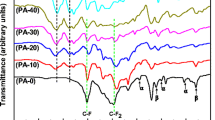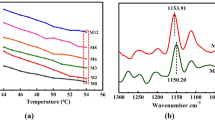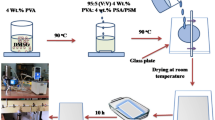Abstract
Permselective polymeric membranes are important materials for the efficient separation of organic solvents and azeotropic mixtures. In this work, we address an effective strategy to the fabrication of novel high-performance membranes of crosslinked poly(vinyl alcohol) (PVA) by incorporating chemically modified cage-structured polyhedral oligomeric silsesquioxane (m-POSS) through solution casting method. The fabricated PVA/m-POSS system showed excellent mechanical stability as well as good pervaporation performance for the separation of isopropanol (IPA)–water azeotropic mixture. Scanning electron micrographs and atomic force microscopy analysis revealed the homogeneous dispersion of m-POSS in PVA matrix. Differential scanning calorimetric studies showed the rigidification of crosslinked PVA matrix by the incorporation of m-POSS. Tensile strength and Young’s modulus of PVA matrix were increased remarkably to 200% and 740%, respectively, in the presence of 5 wt% of m-POSS. Moreover, the membranes exhibited excellent water selectivity, hydrophilicity and excellent anti-fouling properties compared to traditional hydrophilic membranes. At lower filler loading (1.0 wt%), 300% and 200% increase in selectivity and permeance were observed for PVA/m-POSS system over crosslinked PVA. The excellent mechanical properties and other comprehensive properties revealed the potential of the PVA/m-POSS system for the effective separation of azeotropic IPA–water mixture. Modified Maxwell–Stefan model was applied for the theoretical estimation of permeation flux and it was in good agreement with the experimental findings.













Similar content being viewed by others
References
Cheng X, Pan F, Wang M, Li W, Song Y, Liu G, Yang H, Gao B, Wu H, Jiang Z (2017) Hybrid membranes for pervaporation separations. J Membr Sci 541:329–346
Salehian P, Chung TS (2017) Thermally treated ammonia functionalized graphene oxide/polyimide membranes for pervaporation dehydration of isopropanol. J Membr Sci 528:231–242
Nagasawa H, Matsuda N, Kanezashi M, Yoshioka T, Tsuru T (2016) Pervaporation and vapor permeation characteristics of BTESE-derived organosilica membranes and their long-term stability in a high-water-content IPA/water mixture. J Membr Sci 498:336–344
Narkkun T, Jenwiriyakul W, Amnuaypanich S (2017) Dehydration performance of double-network poly(vinyl alcohol) nanocomposite membranes (PVAs-DN). J Membr Sci 528:284–295
Xia LL, Li CL, Wang Y (2016) In-situ crosslinked PVA/organosilica hybrid membranes for pervaporation separations. J Membr Sci 498:263–275
Wu G, Jiang M, Zhang T, Jia Z (2016) Tunable pervaporation performance of modified MIL-53(Al)-NH2/poly(vinyl alcohol) mixed matrix membranes. J Membr Sci 507:72–80
Shan L, Gong L, Fan H, Ji S, Zhang G (2017) Spray-assisted biomineralization of a superhydrophilic water uptake layer for enhanced pervaporation dehydration. J Membr Sci 522:183–191
Kurşun F, Işıklan N (2016) Development of thermo-responsive poly(vinyl alcohol)-g-poly(N-Isopropylacrylamide) copolymeric membranes for separation of isopropyl alcohol/water mixtures via pervaporation. J Ind Eng Chem 41:91–104
Zhao X, Zhang Q, Chen D (2010) Enhanced mechanical properties of graphene-based poly(vinyl alcohol) composites. Macromolecules 43:2357–2363
Chen J, Gao Y, Liu W, Shi X, Li L, Wang Z, Zhang Y, Guo X, Liu G, Li W, Beake BD (2015) The influence of dehydration on the interfacial bonding, microstructure and mechanical properties of poly(vinyl alcohol)/graphene oxide nanocomposites. Carbon 94:845–855
Sharma SK, Prakash J, Sudarshan K, Sen D, Mazumder S, Pujari PK (2015) Structure at interphase of poly(vinyl alcohol)–SiC nanofiber composite and its impact on mechanical properties: positron annihilation and small-angle X-ray scattering studies. Macromolecules 48:5706–5713
Tanaka K, Chujo Y (2012) Advanced functional materials based on polyhedral oligomeric silsesquioxane (POSS). J Mater Chem 22:1733–1746
Swapna VP, Selvin Thomas P, Suresh KI, Saranya V, Rahana MP, Stephen R (2015) Thermal properties of poly(vinyl alcohol)(PVA)/halloysite nanotubes reinforced nanocomposites. Int J Plast Technol 19:124–136
Fang Y, Ha H, Shanmuganathan K, Ellison CJ (2016) Polyhedral oligomeric silsesquioxane-containing thiol–ene fibers with tunable thermal and mechanical properties. ACS Appl Mater Interface 8:11050–11059
Liao WH, Yang SY, Hsiao ST, Wang YS, Li SM, Ma CCM, Tien HW, Zeng SJ (2014) Effect of octa(aminophenyl) polyhedral oligomeric silsesquioxane functionalized graphene oxide on the mechanical and dielectric properties of polyimide composites. ACS Appl Mater Interface 6:15802–15812
McMullin E, Rebar HT, Mather PT (2016) Biodegradable thermoplastic elastomers incorporating POSS: synthesis, microstructure, and mechanical properties. Macromolecules 49:3769–3779
Zhou H, Yea Q, Xu J (2017) Polyhedral oligomeric silsesquioxane-based hybrid materials and their applications. Mat Chem Front 1:212–230
Zhanga W, Müller AHE (2013) Architecture, self-assembly and properties of well-defined hybrid polymers based on polyhedral oligomeric silsequioxane (POSS). Prog Poly Sci 38:1121–1162
Liu L, Hu Y, Song L, Gu XZ, Ni Z (2011) Fabrication of lamellar nanostructure from cage-like poly-anion silicate and surfactant by template-directed synthesis. J Compos Mater 45:307–319
Swapna VP, Jose T, George SC, Thomas S, Stephen R (2018) Pervaporation separation of azeotropic mixture of tetrahydrofuran—water system using nanostructured polyhedral oligomeric silsesquioxane embedded poly(vinyl alcohol). J Appl Poly Sci 135:47060–47069
Shang HM, Wang Y, Limmer SJ, Chou TP, Takahashi K, Cao GZ (2005) Optically transparent superhydrophobic silica-based films. Thin Solid Films 472:37–43
Tsou CH, An QF, Lo SC, Guzman MD, Hung WS, Hu CC, Lee KR, Lai JY (2015) Effect of microstructure of graphene oxide fabricated through different self-assembly techniques on 1-butanol dehydration. J Membr Sci 477:93–100
Jiang SD, Tang G, Bai ZM, Wang Y-Y, Hu Y, Song L (2014) Surface fictionalization of MoS2 with POSS for enhancing thermal, flame-retardant and mechanical properties in PVA composites. RSC Adv 4:3253–3262
Song P, Xu Z, Guo Q (2013) Bioinspired strategy to reinforce PVA with improved toughness and thermal properties via hydrogen-bond self-assembly. ACS Macro Lett 2(12):1100–1104
Yu DS, Kuila T, Kim NH, Lee JH (2014) Enhanced properties of aryl diazonium salt-functionalized graphene/poly(vinyl alcohol) composites. Chem Eng J 245:311–322
Swapna VP, Ponnamma D, Sadasivuni KK, Thomas S, Stephen R (2017) Effect of nanostructured polyhedral oligomeric silsesquioxane on the physical properties of poly(vinyl alcohol). J Appl Polym Sci 134:45447–45456
Guth E (1945) Theory of filler reinforcement. J Appl Phys 16:20–25
Dong Y, Chaudhary D, Ploumis C, Lau KT (2011) Correlation of mechanical performance and morphological structures of epoxy micro/nanoparticulate composites. Compos Part A 42:1483–1492
Zare Y, Daraei A, Vatani M, Aghasafari P (2014) An analysis of interfacial adhesion in nanocomposites from recycled polymers. Comput Mater Sci 81:612–616
Liao YL, Hu CC, Lai JY, Liu YL (2017) Crosslinked polybenzoxazine based membrane exhibiting in situ self promoted separation performance for pervaporation dehydration on isopropanol aqueous solutions. J Membr Sci 531:10–15
Takaba H (2007) Molecular simulation of pressure-driven fluid flow in nanoporous membranes. J Chem Phys 127:054703–054709
Ghosh UK, Pradhan NC, Adhikari B (2006) Separation of water and O-chlorophenol by pervaporation using HTPB-based polyurethaneurea membranes and application of modified Maxwell–Stefan equation. J Membr Sci 272:93–102
Izak P, Bartovska L, Friess K, Sipek M, Uchytil P (2003) Description of binary liquid mixtures transport through non-porous membrane by modified Maxwell–Stefan equations. J Membr Sci 214:293–309
Jose T, George SC, Maya MG, Maria HJ, Wilson R, Thomas S (2014) Effect of bentonite clay on the mechanical, thermal, and pervaporation performance of the poly(vinyl alcohol) nanocomposite membranes. Ind Eng Chem Res 53:16820–16831
Das P, Ray SK, Kuila SB, Samanta HS, Singha NR (2011) Systematic choice of crosslinker and filler for pervaporation membrane: a case study with dehydration of isopropyl alcohol–water mixtures by polyvinyl alcohol membranes. Sep Purif Technol 81:159–173
Acknowledgement
The corresponding author Ranimol Stephen is thankful to DST-SERB (Project No. SR/FTP/PS-123/2012), New Delhi, for the financial assistance.
Author information
Authors and Affiliations
Corresponding author
Additional information
Publisher's Note
Springer Nature remains neutral with regard to jurisdictional claims in published maps and institutional affiliations.
Electronic supplementary material
Below is the link to the electronic supplementary material.
Rights and permissions
About this article
Cite this article
Swapna, V.P., Thomas, S.P., Jose, T. et al. Mechanical properties and pervaporation separation performance of CTAB-modified cage-structured POSS-incorporated PVA membrane. J Mater Sci 54, 8319–8331 (2019). https://doi.org/10.1007/s10853-019-03479-8
Received:
Accepted:
Published:
Issue Date:
DOI: https://doi.org/10.1007/s10853-019-03479-8




